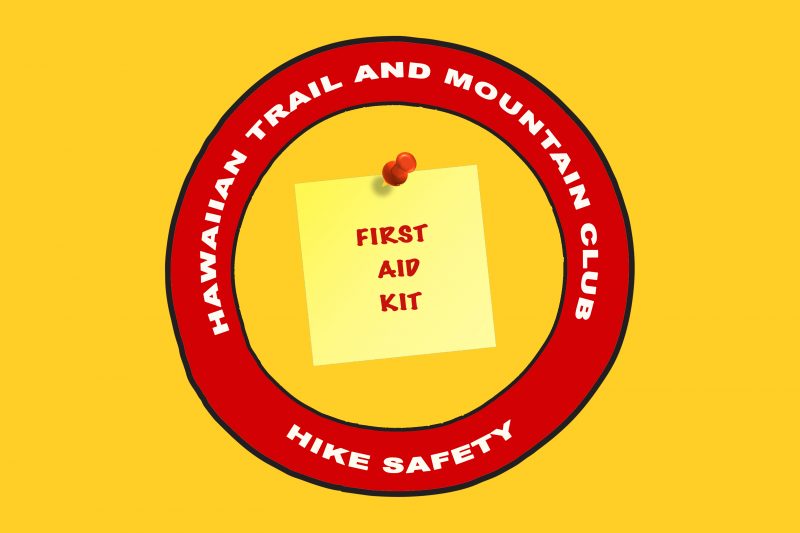
On an HTMC Hike, every participant ideally brings their own first aid kit. It is one of the Carry In Your Pack Essential Items HTMC recommends for all hikers. Things can happen (injury or illness) and HTMC Hike Coordinators do not carry a group first aid kit. With your kit, you can treat yourself or care for a fellow hiker in need. You should be prepared for the common injuries and illnesses in addition to more serious situations.
There is no such thing as a perfect first aid kit. If you tried to bring everything you could possibly need, your pack would be too heavy and bulky for a day hike. Every company selling pre-made kits has their own opinion on what should be included.
Here are some thoughts on what to consider for your individual day hike first aid kit whether you are making your own kit or buying a kit
Organization
First decide if you want one kit for all items or several smaller bags for different needs (urgent life-threatening needs, basic wound care needs, etc.).
Accessibility
Especially in an emergency, you may want a few items ASAP. Items like gloves, gauze pads to stop severe bleeding, paramedic shears, and a CPR mask. These could be in a Ziplock bag at the top of your pack. Best to not have your kit buried at the bottom of your pack and have to take everything out to find it, especially when it is raining!
Bag
Ideally, your items are carried in a lightweight waterproof or water resistant bag. Small toiletry bags, dry bags, or even plastic zip-lock baggies work. It is helpful to keep similar items in smaller zip-lock baggies.
Protection for Self
- Gloves (first aid nitrile gloves)
- Hand sanitizer (clean hands before and after)
Also Consider
- CPR mask (lightweight keychain version) – if trained
Scrapes, Minor Cuts, and Splinters
- Antiseptic wipes to clean minor wound and skin around the wound
- Antibiotic ointments
- Band-Aids – variety of sizes
Also Consider
- Gauze pads (4×4 or smaller) to help stop bleeding and cleaning.
- Roller gauze to wrap cover wounds after cleaning and dressing.
- Tweezers to remove dirt and splinters. (clean before and after use)
- Irrigation syringe to clean wounds with clean water.
- Medical tape to keep bandages in place.
- Small swiss army knife or multi-tool (scissors, knife, tweezers)
Sprains and Fractures
- Ace bandage or self-adhesive wrap.
- Triangular bandage
Also Consider
– SAM (structural aluminum malleable) Splint
Severe Bleeding
- Gloves
- Gauze Pads (Several 4X4’s or thicker Abdominal Pad)
- Paramedic shears (scissors)
Also Consider
- Hemostatic dressings (like Quick Clot), if on blood thinners or other clotting issues.
- Tourniquet (if trained)
Medication
The administration of medications to others including over the counter nonprescription medications can be legally controversial.
Recommendation: Be cautious when sharing your medication with others, due to possible allergic reactions. Each hiker should provide their own medication and know their recommended usage and dosage.
- Over-the-counter pain medication for aches and pains
- Antihistamine for allergic reactions to bites and stings (Benadryl, Zyrtec, Claritin).
Also Consider
- Anti-sting wipes – relieves itchiness from mosquito and other insect bites
- Aspirin (chewable) – for chest pain
Personal Medication needs
- Bring your personal Epi-Pen if you have a severe allergy and make sure someone you hike with knows where it is and how to use it.
- Bring your personal medications and make sure fellow hikers know how to find and administer it.
- Nitroglycerine
- Diabetes medications and testing equipment
Other Items on the Carry In your Pack Essential Items listed on the Hike Safety HTMC website page are helpful in preventing and treating injuries and illnesses.
First Aid Info and Training
- Book or cards with first aid information
- Training – Recommend taking a basic first aid class or a Wilderness First Aid class
The above suggestions will hopefully help with the challenging balance between having too much versus too little first aid supplies. Again, there is no perfect first aid kit. Start with something and then as you use your supplies or hear about hiking injuries and/or illnesses, decide on adding or deleting items from your kit. And on a regular basis check your kit: have things gotten damaged (dirt, water, etc.), expired, or need to be replenished.
And maybe most important: have the knowledge of what to do in a first aid emergency. Taking first aid classes will help prepare your brain to handle an emergency and successfully use the items in your kit.
